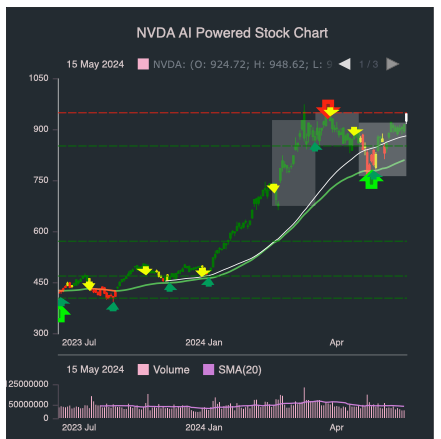20 Free News To Selecting AI Stock Predictions Platform Websites
20 Free News To Selecting AI Stock Predictions Platform Websites
Blog Article
Top 10 Suggestions For Looking At Ai And Machine Learning Models On Ai Trading Platforms
The AI and machine (ML) model utilized by stock trading platforms as well as prediction platforms should be evaluated to make sure that the information they provide are precise, reliable, relevant, and applicable. Poorly designed or overhyped models can lead flawed predictions, and even financial losses. Here are the top 10 strategies for evaluating AI/ML models on these platforms.
1. Know the Model's purpose and Method of Approach
Clarity of purpose: Determine if this model is intended for short-term trading or long-term investment, risk analysis, sentiment analysis etc.
Algorithm Transparency: Check if the platform is transparent about what kinds of algorithms are employed (e.g. regression, neural networks of decision trees, reinforcement-learning).
Customization. Assess whether the model's parameters are adjusted to fit your specific trading strategy.
2. Evaluation of Performance Metrics for Models
Accuracy - Examine the model's accuracy in predicting. But don't rely exclusively on this measurement. It can be misleading on the financial markets.
Precision and recall: Evaluate whether the model is able to identify true positives (e.g., correctly predicted price movements) and minimizes false positives.
Risk-adjusted returns: Assess the likelihood that the model's predictions will lead to profitable trades after accounting for risk (e.g., Sharpe ratio, Sortino ratio).
3. Make sure you test the model using Backtesting
Historical performance: Test the model with historical data to determine how it would have performed under different market conditions in the past.
Testing outside of sample The model should be tested using data that it was not trained on to prevent overfitting.
Analyzing scenarios: Evaluate the model's performance in various market conditions (e.g. bull markets, bear markets and high volatility).
4. Be sure to check for any overfitting
Overfitting Signs: Look for models which perform exceptionally well when trained but poorly with untrained data.
Regularization methods: Check that the platform doesn't overfit by using regularization like L1/L2 and dropout.
Cross-validation. Ensure the platform performs cross validation to test the generalizability of the model.
5. Examine Feature Engineering
Look for features that are relevant.
The selection of features should make sure that the platform selects features with statistical importance and avoid redundant or unneeded data.
Dynamic feature updates: Find out whether the model will be able to adjust to changes in market conditions or the introduction of new features in time.
6. Evaluate Model Explainability
Model Interpretability: The model needs to provide clear explanations to its predictions.
Black-box model: Beware of platforms which use models that are overly complex (e.g. deep neural network) without explaining the tools.
User-friendly insights : Determine if the platform offers actionable data in a form that traders can use and comprehend.
7. Review the model Adaptability
Market conditions change - Check that the model can be modified to reflect changes in market conditions.
Continuous learning: Ensure that the platform is regularly updating the model by adding new data to boost performance.
Feedback loops: Ensure that the platform integrates real-world feedback as well as user feedback to improve the design.
8. Examine for Bias in the elections
Data bias: Ensure that the information used to train is a true representation of the market and without biases.
Model bias: Find out whether the platform monitors and mitigates biases in the predictions made by the model.
Fairness. Make sure your model isn't biased towards certain industries, stocks or trading techniques.
9. The Computational Efficiency of a Program
Speed: See whether the model can make predictions in real-time or at a low latency. This is especially important for high-frequency traders.
Scalability Check the platform's capability to handle large data sets and users simultaneously without performance degradation.
Utilization of resources: Determine if the model has been optimized for the use of computational resources efficiently (e.g., GPU/TPU utilization).
Review Transparency and Accountability
Model documentation - Make sure that the platform has detailed information about the model, including its structure as well as training methods, as well as limitations.
Third-party audits: Verify whether the model has been independently audited or validated by third-party auditors.
Make sure that the platform is fitted with mechanisms that can detect model errors or failures.
Bonus Tips:
User reviews and case studies Utilize feedback from users and case studies to assess the performance in real-life situations of the model.
Trial period: Try the software for free to test the accuracy of it and how easy it is to utilize.
Customer Support: Verify that the platform has solid technical or models-related assistance.
Check these points to evaluate AI and ML models for stock prediction, ensuring that they are reliable, transparent and in line with the trading objectives. View the most popular continue reading this about best ai stock trading bot free for blog recommendations including ai trading tools, ai trading, options ai, ai investing platform, ai investing, ai investing platform, best ai stock trading bot free, trading with ai, best ai stock, investment ai and more.
Top 10 Suggestions For Evaluating The Ai-Powered Stock Trading Platforms As Well As Their Educational Resources
The users must review the educational materials provided by AI trading and stock prediction platforms to know the platform and its functions in order to make informed trading choices. Here are the top 10 ways to assess the value and the quality of these education resources.
1. Comprehensive Tutorials, Guides and Instructions
Tip: See whether there are tutorials or user guides for advanced and beginner users.
Why: Clear instructions will assist users to navigate and comprehend the platform.
2. Video Demos and Webinars
Tips: Search for videos of demonstrations, webinars or training sessions that are live.
Why is that visual and interactive content makes complex concepts simpler to comprehend.
3. Glossary
Tip: Ensure the platform has the definitions or glossaries of important financial and AI-related terms.
This is to help users, and especially beginners to grasp the terminology that are used in the application.
4. Case Studies and Real-World Examples
Tip - Check to see whether the AI platform has actual case studies or applications of AI models.
How do you know? Practical examples can aid users in understanding the platform and its capabilities.
5. Interactive Learning Tools
TIP: Look for interactive features like games and sandboxes.
Why Interactive tools are a great way to learn and test your skills without risking real cash.
6. Regularly updated content
TIP: Make sure to check whether the educational materials reflect any changes to the marketplace, rules or other new features.
What's the reason? Outdated information can lead to misinterpretations or incorrect application of the platform.
7. Community Forums and Support with
Join active support forums and forums to ask questions or share your knowledge.
Why: Expert and peer advice can aid students in learning and solve issues.
8. Programs of Accreditation or Certification
Check if it offers accredited or certified courses.
Why: Formal recognition of knowledge can increase credibility and inspire users to increase their knowledge.
9. Accessibility and User-Friendliness
Tip: Check how easily accessible and user-friendly educational sources are.
What's the reason? It's because it's easier for users to learn at their own pace.
10. Feedback Mechanisms for Educational Content
Tip: Check if the platform allows users to provide feedback on the educational materials.
The reason is that the feedback of users helps to improve the quality and relevance of the content.
Learn in a variety formats
The platform must offer the widest range of learning options (e.g. video, audio and text) to meet the requirements of a variety of learners.
If you take a thorough look at these factors and evaluating them, you will be able to decide if the AI trading and stock prediction platform offers a wealth of educational resources which will allow you to maximize the potential of it and make educated trading decision. Follow the best ai tools for trading for blog advice including best ai for stock trading, ai software stocks, best ai stocks, ai options, best ai stocks, best ai trading platform, ai copyright signals, ai in stock market, ai in stock market, stocks ai and more.